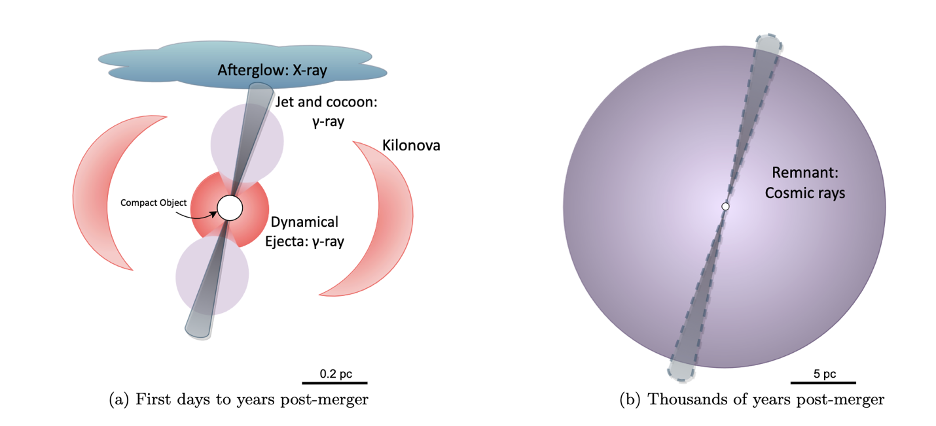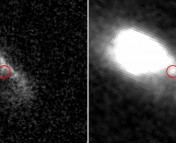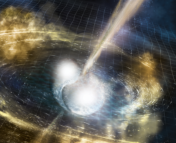Title: Could a Kilonova Kill: a Threat Assessment
Authors: Haille M. L. Perkins, John Ellis, Brian D. Fields, Dieter H. Hartmann, Zhenghai Liu, Gail C. McLaughlin, Rebecca Surman, Xilu Wang
First Author’s Institution: University of Illinois Urbana-Champaign
What is a Kilonova?
When a neutron star merges with either another neutron star (binary neutron star; BNS) or a black hole (NSBH), the resulting explosion is very violent and bright. This explosion produces an optical signature, known as a kilonova; a short gamma-ray burst (sGRB); gravitational waves; and even cosmic rays. Because kilonovae can be detected through so many different “messengers”, they are the first truly multimessenger astrophysical sources. They are also the only known source of r-process nucleosynthesis, the only nuclear process for producing the most massive elements on the periodic table including gold, the lanthanides, and the actinides. Kilonovae have been the subject of numerous excellent bites in the past, including this, this, and even this. Read this guide we have written that explores kilonovae in more detail, and highlights the only well-studied kilonova to date: GW170817A. Today’s paper explores the risk kilonovae pose to the Earth. In particular, the paper characterizes how the gamma rays, x-rays, and cosmic rays from kilonovae can negatively impact the Earth’s ozone layer. The authors of this paper provide a measure of the ‘kill distance’ for each source of radiation from the kilonova, a measure of how close the kilonova would have to be to the Earth to create significant ozone depletion.

When a binary neutron star system (or a NSBH system) merges, the resulting explosion is a complex event that, depending on the angle it is viewed from, emits some combination of x-rays, gamma-rays, cosmic rays, neutrons, and ejecta that is launched from the central binary system. The left panel of Figure 1 from the paper shows the anatomy of this event, highlighting the different emissions from the merger in the ensuing days. Many years after the explosion (right panel, Figure 1), the shockwave emitted from the merger will work to sweep out surrounding material, creating a bubble in the interstellar medium that continues to spread out as the material continues to move outwards from the merger location.
Risk Calculations
To calculate the risk posed by each aspect of kilonovae, the authors calculate the total energy that the Earth would encounter within specific bands of radiation over the course of four years. It is estimated that after four years, the ozone layer can recover from significant damage. It is also estimated that ~30% depletion of the ozone layer would result in extinction-level damage. As such, the authors of this paper define the kill distance as the distance at which a merger event would result in enough energy absorbed by the Earth’s ozone layer to result in 30% depletion within four years.
Sources of Danger: The Jet
Characteristic of the short GRB created by this merger is the jet of high-energy gamma-ray photons that is launched along one, tightly constrained direction. The jets of short GRBs like the one created by the merger event in GW 170817A generally last for ~2 seconds, emitting a total energy of 10^46-10^51 ergs (relate this to the luminosity of the sun and of the MW). If such a GRB jet was pointed directly towards the Earth, the kill distance would range between 1 and 300 parsec. Modeling the GW 170817A kilonova suggests a kill distance of 200 pc. For context, a 300 parsec sphere centered on the Earth would only include the stars that are closest to the Earth. Even the closest neutron star is 400 parsec away, and all the kilonovae we have detected didn’t even happen in the Milky Way galaxy (with the closest one at ~tens of megaparsec away from the Earth).
However, because the jet is so tightly constrained in one direction, this kill distance drops dramatically as the angle between the jet and the direction to the Earth changes. This paper finds that by aligning the Earth just ~6 degrees from the jet direction the kill distance would drop to less than 40 parsec and by ~10 degrees the kill distance is negligible. Therefore, the jet presents a negligible risk unless it is pointed almost precisely towards the Earth, and other aspects of the kilonova are likely more dangerous.
Sources of Danger: X-rays, Gamma-rays, and Cosmic Rays
As photons from the jet collide with and excite the surrounding matter, the matter will become energized and emit an x-ray afterglow. The X-ray afterglow produced by the energized material surrounding the merger also presents some risk to the Earth atmosphere. Most of the X-rays emitted have energy between 3 kev and 10 kev. For X-rays too, the authors find an angular dependence on the jet direction, and find that the kill distance is ~12 parsec in the direction along the jet, but drops below 1 parsec by just 5 degrees outside the jet direction. Gamma-rays are also emitted by both r-process nucleosynthesis and by scattering of photons from the GRB jet by surrounding material. However, these gamma-rays have a relatively small kill distance of ~4 parsec. Because scattering of GRB jet photons also depends on the angle with the jet, this kill distance also decreases substantially as a function of viewing angle.
The last source of danger considered by the authors of this paper is cosmic ray emission following merger. In the several centuries following merger, the ejecta will create a bubble in the surrounding interstellar material. The remnant after merger, similar to a supernova remnant, is expected to generate cosmic rays for several centuries afterwards. Moreover, the cosmic rays generated by the remnant will remain within the expanding bubble. Once the bubble from a hypothetical nearby kilonova has expanded to the location of the Earth, these cosmic rays will hit the Earth’s atmosphere, presenting a possible risk to the ozone layer. The authors find a kill distance of ~11 parsec for cosmic ray emission from kilonovae. In addition, they note that these cosmic rays would only reach the Earth millenia after the photons from the kilonova are detected.
The Verdict? We’re Probably Safe!
Such very early observations are extremely rare for Type II supernovae because most are too far away to be
Now that the authors have explored all the possible dangers of kilonovae to the Earth, they also comment on whether we expect any of these dangers to influence life on Earth. By modeling the number of stellar systems expected to form BNS or NSBH systems, one can calculate the expected rate of occurrence of kilonovae within our galaxy. The authors find that even within the highest kill distance of 11 parsec from merger cosmic ray emission, the rate of kilonovae within a radius of 11 parsec is extremely low. In fact, because these mergers are so rare, the average time between successive kilonovae within this distance to the Earth is around 500 times the amount of time since the big bang! The authors conclude that mergers that create kilonovae are unlikely to ever influence life on Earth, and that the risk posed by supernovae is much larger, simply because they are more frequent.
Therefore, the risk posed to life on Earth by kilonovae is likely very low. However, it is interesting to consider the risk posed to our technological civilization. Ion storms in the atmosphere caused by sudden bursts of gamma rays might cause electrical fires and knock out our electrical communication systems. Such ion storms are much more likely to be caused by flares from the Sun, and events like the Carrington Event are expected to create significant damage to our modern electrical infrastructure. Therefore, we are working on improving our infrastructure and even brainstorming massive space-based shields to protect our planet!
Astrobite edited by Keighley Rockcliffe
Featured image credit: ESO/L. Calçada/M. Kornmesser + Edited on Microsoft Word




